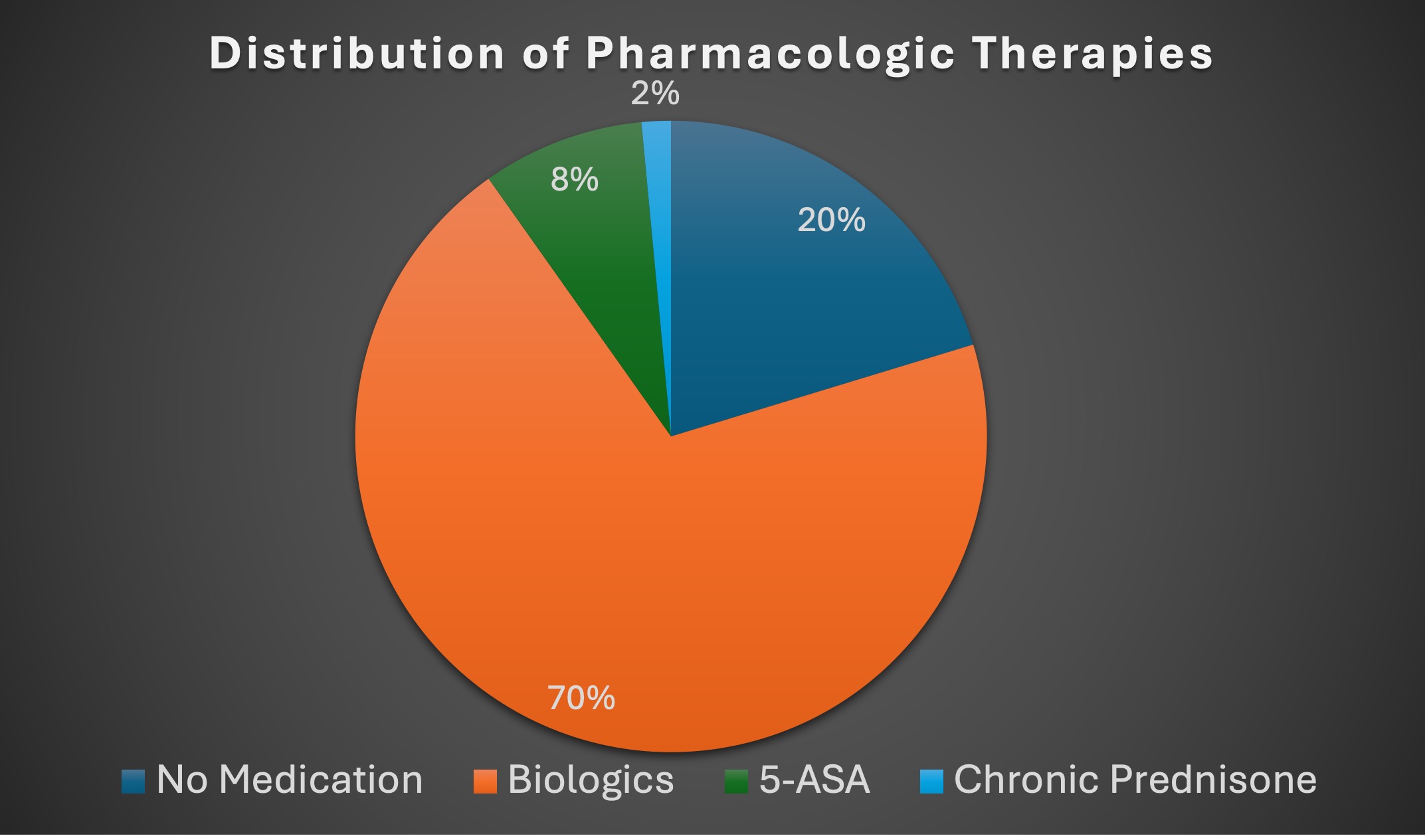Monday Poster Session
Category: IBD
P2606 - Evaluating the Continued Use of 5-Aminosalicylates in Crohn's Disease: Insights From A Single-Center Study
Monday, October 28, 2024
10:30 AM - 4:00 PM ET
Location: Exhibit Hall E

Has Audio

Alexander M. Carlson, DO
University at Buffalo
Buffalo, NY
Presenting Author(s)
Alexander M. Carlson, DO1, Weam Altaher, DO1, Courtney Dennis, MD2, Ikjot Singh, MD1, John Cleary, DO1, Erin Ly, MD1
1University at Buffalo, Buffalo, NY; 2University of Buffalo, Buffalo, NY
Introduction: The management of Crohn's disease (CD) has evolved significantly, with the American College of Gastroenterology's 2018 guidelines recommending against the use of 5-aminosalicylates (5-ASA) due to their limited efficacy against placebo. Despite these updated recommendations, a substantial number of Crohn's disease patients continue to be prescribed 5-ASA’s. This study aims to assess the prevalence of 5-ASA use among Crohn's disease patients and evaluate adherence to current therapeutic guidelines. Understanding these prescribing patterns is crucial for optimizing patient outcomes.
Methods: We identified patients, ages 18-70, who were diagnosed with CD that visited our gastroenterology clinic from 2020-2023. Their electronic medical records were analyzed for current and past pharmacologic therapies, prescription fill history, and prescriber information. Results were calculated using simple mathematics.
Results: We identified 150 patients in this study. 27 patients (20.3%) were not taking pharmacologic therapy due to quiescent disease activity. 93 patients (69.9%) were on biologic therapies. 2 patients (1.5%) were on chronic prednisone therapy due to biologic refusal. 11 patients (8.3%) were taking 5-ASA’s, with the most common being mesalamine (Figure 1) All of the active prescriptions for 5-ASA’s were through primary care offices.
Discussion: In conclusion, our study highlights a significant issue in the management of Crohn's disease, with a notable number of patients continuing on 5-ASA’s despite updated guidelines. Previous larger studies in Canada have suggested that as much as one third of CD patients continue to be prescribed 5-ASA's. The persistence of these prescriptions, particularly among patients lost to follow-up, underscores the need for improved monitoring and adherence to current therapeutic recommendations. By addressing these gaps, we aim to enhance the quality of care and improve outcomes for our patients with CD.

Disclosures:
Alexander M. Carlson, DO1, Weam Altaher, DO1, Courtney Dennis, MD2, Ikjot Singh, MD1, John Cleary, DO1, Erin Ly, MD1. P2606 - Evaluating the Continued Use of 5-Aminosalicylates in Crohn's Disease: Insights From A Single-Center Study, ACG 2024 Annual Scientific Meeting Abstracts. Philadelphia, PA: American College of Gastroenterology.
1University at Buffalo, Buffalo, NY; 2University of Buffalo, Buffalo, NY
Introduction: The management of Crohn's disease (CD) has evolved significantly, with the American College of Gastroenterology's 2018 guidelines recommending against the use of 5-aminosalicylates (5-ASA) due to their limited efficacy against placebo. Despite these updated recommendations, a substantial number of Crohn's disease patients continue to be prescribed 5-ASA’s. This study aims to assess the prevalence of 5-ASA use among Crohn's disease patients and evaluate adherence to current therapeutic guidelines. Understanding these prescribing patterns is crucial for optimizing patient outcomes.
Methods: We identified patients, ages 18-70, who were diagnosed with CD that visited our gastroenterology clinic from 2020-2023. Their electronic medical records were analyzed for current and past pharmacologic therapies, prescription fill history, and prescriber information. Results were calculated using simple mathematics.
Results: We identified 150 patients in this study. 27 patients (20.3%) were not taking pharmacologic therapy due to quiescent disease activity. 93 patients (69.9%) were on biologic therapies. 2 patients (1.5%) were on chronic prednisone therapy due to biologic refusal. 11 patients (8.3%) were taking 5-ASA’s, with the most common being mesalamine (Figure 1) All of the active prescriptions for 5-ASA’s were through primary care offices.
Discussion: In conclusion, our study highlights a significant issue in the management of Crohn's disease, with a notable number of patients continuing on 5-ASA’s despite updated guidelines. Previous larger studies in Canada have suggested that as much as one third of CD patients continue to be prescribed 5-ASA's. The persistence of these prescriptions, particularly among patients lost to follow-up, underscores the need for improved monitoring and adherence to current therapeutic recommendations. By addressing these gaps, we aim to enhance the quality of care and improve outcomes for our patients with CD.

Figure: Figure 1: Pie chart demonstrating the treatment modalities of the CD patients in our study.
Disclosures:
Alexander Carlson indicated no relevant financial relationships.
Weam Altaher indicated no relevant financial relationships.
Courtney Dennis indicated no relevant financial relationships.
Ikjot Singh indicated no relevant financial relationships.
John Cleary indicated no relevant financial relationships.
Erin Ly indicated no relevant financial relationships.
Alexander M. Carlson, DO1, Weam Altaher, DO1, Courtney Dennis, MD2, Ikjot Singh, MD1, John Cleary, DO1, Erin Ly, MD1. P2606 - Evaluating the Continued Use of 5-Aminosalicylates in Crohn's Disease: Insights From A Single-Center Study, ACG 2024 Annual Scientific Meeting Abstracts. Philadelphia, PA: American College of Gastroenterology.
